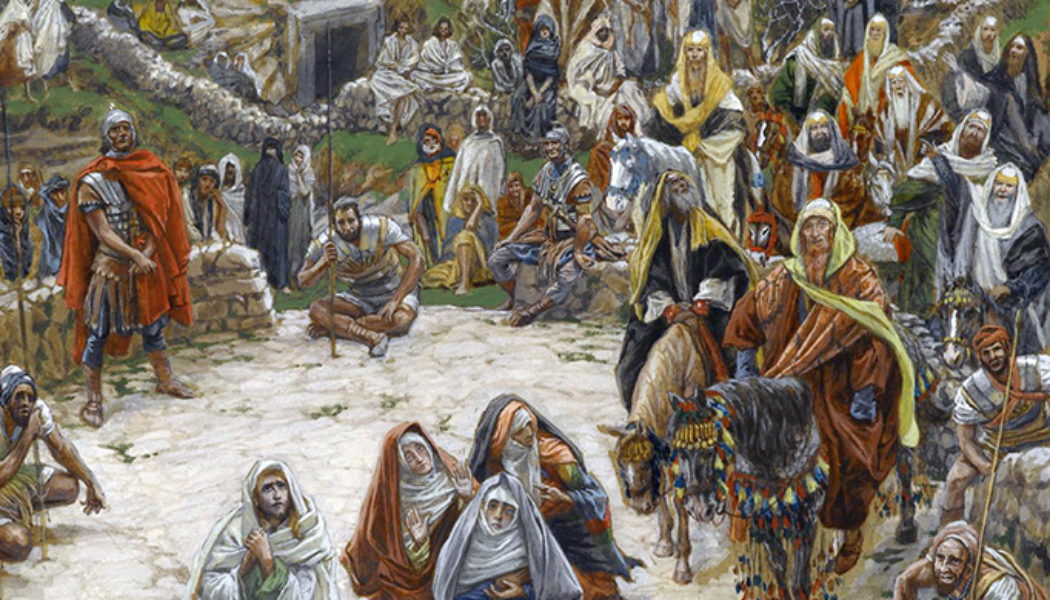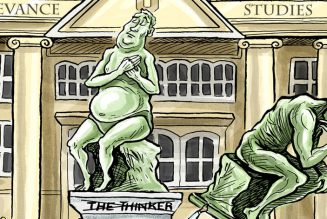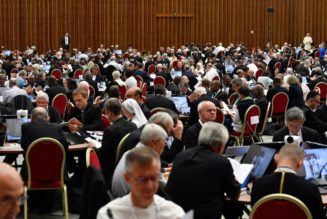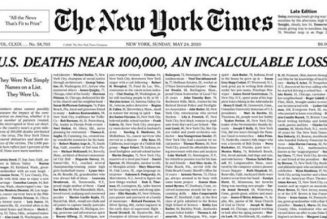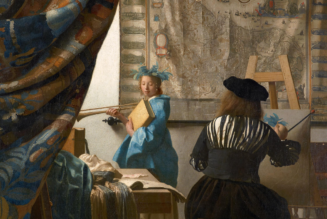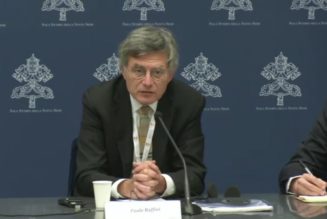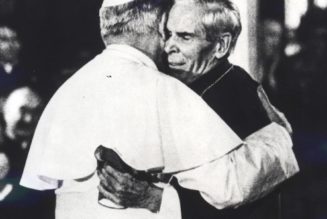
(Matthew 27:35-61; Mark 15:21-47; Luke 23:26-56; John 19:18-42)
If you stop and think about it, the Christian message is utterly out of sync with what human beings would expect. That the Son of the All-Powerful and Ever-Living God would allow himself to be brutally killed, tortured for hours by some people in a backwater place in the Roman Empire, boggles the mind. That he should have allowed that out of love for human beings, from whom gratitude was not assured, is even more mind-boggling. That he even bothered … shows you what Love means.
God could have redeemed us however he chose. In suffering for our sins, Jesus is teaching us, showing us graphically just how hateful, destructive, violent and malicious sin is. “For us men and our salvation,” he came down from heaven. To teach us he came down from heaven.
And do we listen?
St. Paul captures this paradox of Christianity when he speaks of the “foolishness of the cross.”
“We preach Christ crucified: a stumbling block for Jews and a folly to Gentiles … but for those who are called, Christ is the power of God and the wisdom of God” (1 Corinthians 1:23-24). That requires a change of mindset. When Peter failed to see that, Jesus rebuked him: “You are thinking not as God does, but as human beings do” (Matthew 16:23). Calvary is the ultimate test of whether we measure things by God’s or human standards. It is the ultimate proof that, as Jesus earlier told his disciples, “If anyone would follow me, he must deny himself …” (Matthew 16:24).
The Gospels, whose accounts of Jesus’ crucifixion, death and deposition from the cross are somewhat extensive, primarily focus on the people on top of Calvary hill. They represent a cross-section of humanity. His enemies, who see in his being hung from a tree proof positive that God rejected this troublemaker, are milling around, gloating. “The chief priests, the teachers of the law, and the elders mocked him” (Matthew 27:41). They throw his words back in his face. Miracle worker, how about a miracle? Passers-by join in the jeers: “Come down from that cross if you are the Son of God” (Matthew 27:40). Bored soldiers sit there. Sometimes they join in the invective. Sometimes they just administer the scene, keeping a semblance of order until the prisoners die.
His Mother Mary and John are there, along with a few other friendly but physically powerless faces. Some are at the foot of his cross; others “kept watch from a distance” (John 19:25; Matthew 27:55). Mary undoubtedly remembered an old man’s words from decades prior about a sword piercing her heart. John and Mary are pretty much what the Church is that Good Friday, when Mary becomes the Mother of that Church (John 19:26-27).
There are also two other men crucified. Like Jesus, they are staring death in the eye. Their reactions illustrate the choices everyman faces at that moment. One persists in the hatred and sins that marked his life, joining in the mocking of Christ. He is not a man of hope. “You unfortunately caught me: that’s how things happen. Just an unlucky roll of the dice.” The other seizes his last moments on this earth to evaluate his life, to think about truth and lies, justice and injustice, and to seek mercy. He defends Jesus, though all he has at his disposal are words. But he is a man of hope: the future need not be the past, and it’s not just a senseless end. He asks for mercy: “Jesus, remember me when you enter your Kingdom.” And, as the poet put it, “He mercy asked, and he mercy found.”
The late Slovak Cardinal Ján Korec described the encounter with the thieves this way: Jesus was exactly where he wanted to be, absolving his last penitent. He came into this world to die to save sinners. And, even as he was dying, he saved one.
The Gospels speak of Jesus crying out “My God, my God, why have You abandoned me?” Did the Father ever abandon Jesus? No. But Jesus chose to share our humanity in its entirety so, in suffering for our sins, Jesus also willed to feel what sinful man feels. And sinful man feels God’s abandonment in his sins. For Jesus, “God from God, Light from Light, True God from True God,” eternally intimate with the Father, he let himself experience the horror of the radical alienation from God that sin causes in us.
Because we need to feel that alienation in order to recognize our need to return to him. And because, if we don’t, that sense of abandonment simply grows into its mature fruit: hell. Theologians, after all, speak of hell in terms of the “pain of loss” and the “pain of sense,” and while human beings — who are so immersed in sensory experience — focus on the latter, the essence of hell is precisely the former. The essence of hell is the loss of God … forever.
Jesus dies. Death and Satan think they have won. They have put God to death. But, like today’s fools who also prattle on about the “death of God,” Satan realizes he is the biggest loser. The soul of Christ is already kicking in the doors of hell. And we often overlook a passage from Matthew:
And behold, the veil of the sanctuary was torn in two from top to bottom. The earth quaked, rocks were split, tombs were opened, and the bodies of many saints who had fallen asleep were raised. And coming forth from their tombs after his resurrection, they entered the holy city and appeared to many (Matthew 27:51-53).
All these things are actions of the Holy Spirit, the “Lord and Giver of Life” who rips the veil between God and man. We don’t need to wait until Pentecost (although that is the full gift of the Spirit) — when Jesus’ side is opened, from which “blood and water, the fountain of sacramental life in the Church” spills out, the Holy Spirit breaks into a world that, since Adam and Eve, God has been planning to take back to himself. And since “no one can say Jesus is Lord except by the Holy Spirit” (1 Corinthians 12:3), we already have proof of the Spirit’s Presence as the Centurion declares, “Truly, this was the Son of God!” (Matthew 27:54).
The heart of this Mystery is found in John 3:16: “God so loved the world that he gave his only Son” to save us.
This Mystery is depicted in art by the late-19th-century French painter, James Tissot. Tissot experienced a profound conversion late in life and painted an entire series of works illustrating the life of Christ in great detail. He visited the Holy Land, so his paintings seek to be very authentic to the sights, looks and appearances of Israel: they are not his day transplanted into antiquity. The painting is held by the Brooklyn Museum.
I chose Tissot’s depiction of the crucifixion because its point of view is very unusual. Most crucifixion scenes show us looking at Jesus. They typically include the Calvary scene, with the two thieves on adjacent crosses and the Blessed Mother and St. John in grief at the foot of the cross.
The title of Tissot’s painting changes that perspective. “Ce qui voyait Notre-Seigneur sur la croix” [What Our Savior Saw from the Cross] looks on the scene of the Crucifixion out of Jesus’ eyes, from what he saw on the cross.
Shakespeare’s immortal line would fit Jesus’ vision: “All the world’s a stage, and all the men and women … players.” What I left out from the Bard’s quote is the word “merely.” Jesus sees all the human actors immediately involved in his Passion. None of them are “merely” there — there are no accidents in life.
There are the few friends. Mary, closest to the cross, is there with her red hair from beneath her veil. His Mother Mary, “his mother’s sister, [and] Mary the wife of Clopas” (John 19:25) are bunched together, John to their right.
A large group of the Temple establishment is off on the right, one on his high horse, others on their low mules, some smirking, a few jeering and gesticulating. On the right, an armored soldier likewise mocks Jesus, perhaps one of those who drove thorns into his head earlier that day. A couple of other soldiers are found toward the center, generally in the posture of functionaries. Others pass by, some indifferent, some with a morbid curiosity, some just passing time. There’s also a tomb waiting: Death asserts its demand.
I am no painter, but I would welcome one with talent to repaint this scene on the lines of Botticelli’s “Mystical Nativity.” Jesus also undoubtedly saw not just the human actors of that Friday afternoon in Israel. He saw the spiritual actors — the Devil and demons — joining in the jeers. And he undoubtedly saw humanity — you and me — with our own spiritual baggage on that hill. The question is, like the thieves, are we among the repentant or impenitent?
Lastly, I chose this painting because it illustrates a valuable spiritual practice, what Jesuits call the “examen.” The “examen,” which should occur at the end of the day, is not just an “examination of conscience,” a repentance of my failings for that day. The examen is something bigger. It asks me to look at everything in the past day — the good, the bad and the “neutral” — trying to see how it fit and came into my life through the eyes of God. The examen asks me to stop looking at myself through my eyes and ask the Holy Spirit to help me see myself as God sees me and my life.
As Jesus saw us from the cross.
